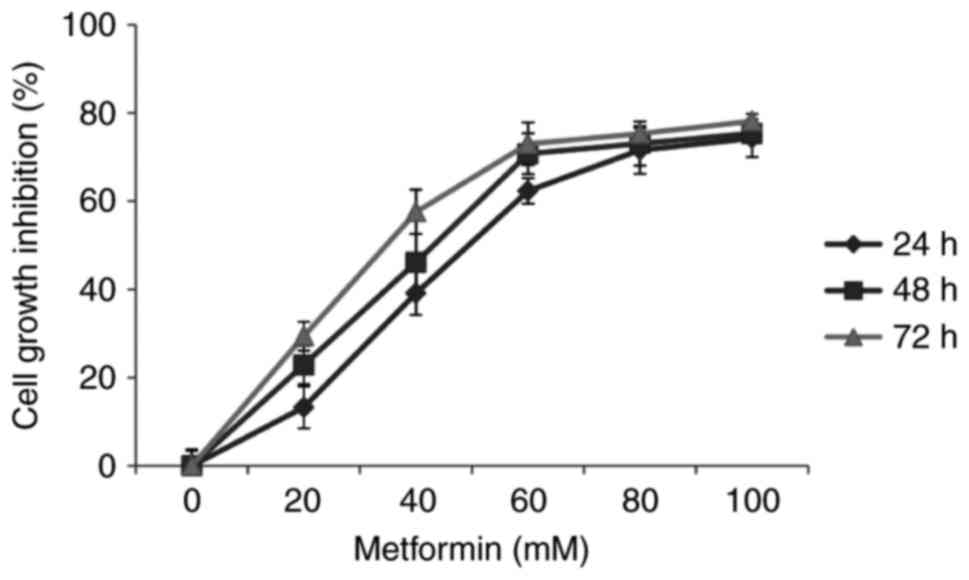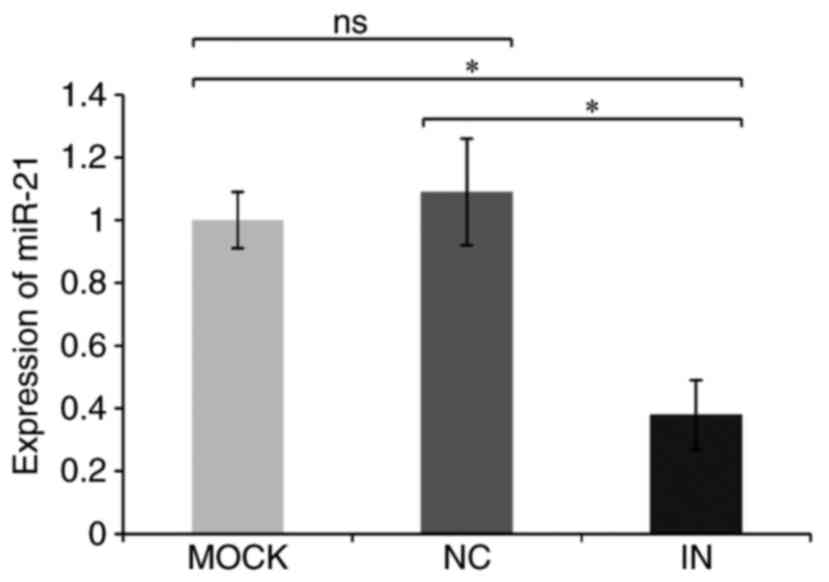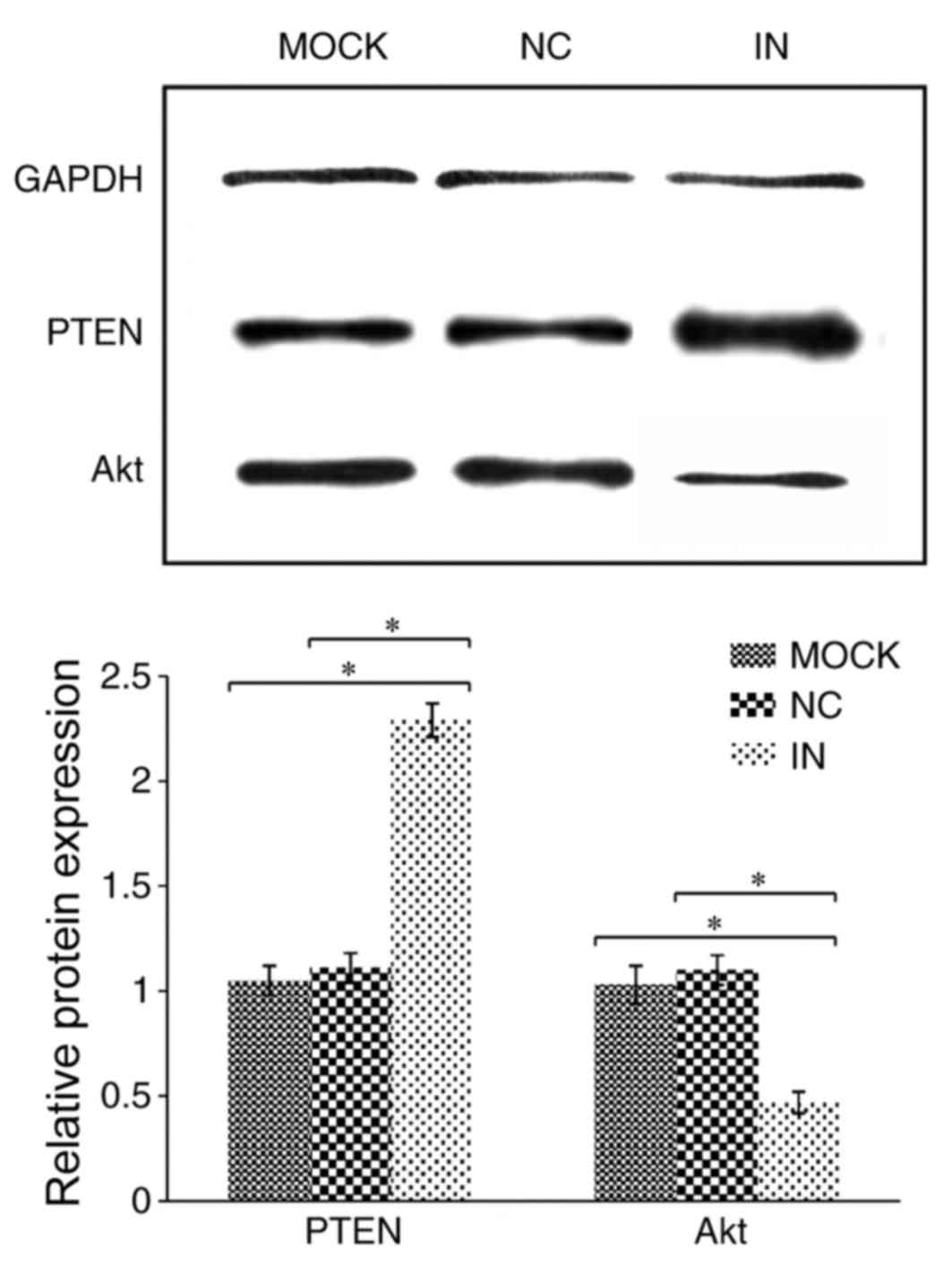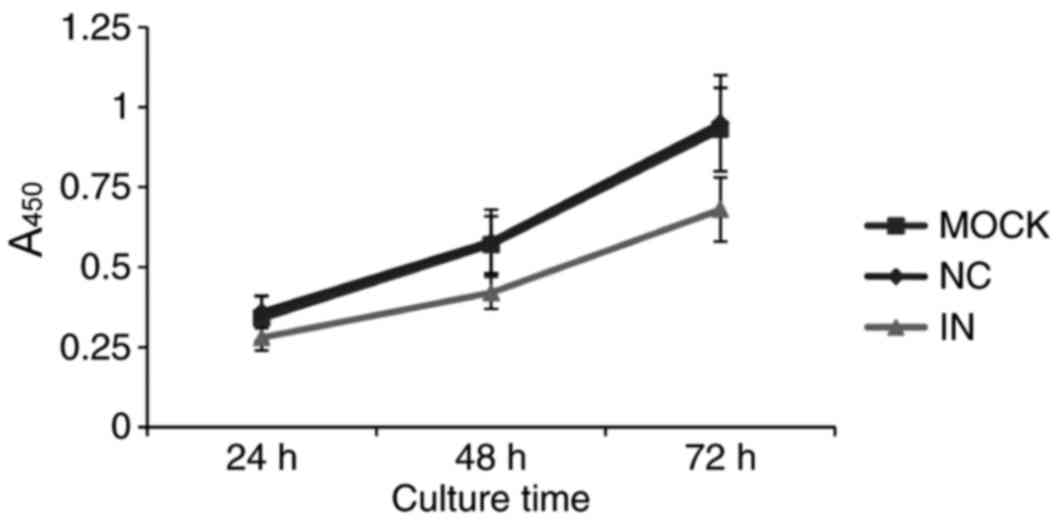Metformin inhibits HaCaT cell viability via the miR-21/PTEN/Akt signaling pathway
- Authors:
- Published online on: December 27, 2017 https://doi.org/10.3892/mmr.2017.8364
- Pages: 4062-4066
Abstract
Introduction
HaCaT cells are an immortalized, non-tumorigenic cell line derived from keratinocytes of normal adult skin (1). Pathologically excessive proliferation of these cells reportedly leads to various skin diseases, such as psoriatic lesions and various skin cancers (2). Thus, HaCaT cells are extensively employed as an extrinsic cell instrument in anti-neoplastic medicine experiments (3). Metformin, a biguanide insulin sensitizer widely prescribed to type 2 diabetes (4), has gained increasing focus due to its newly discovered anti-neoplastic capacity in a broad spectrum of malignant tumors, including prostate, pancreatic, ovarian and gastric cancers (5–8). However, the anti-growth ability of metformin seems to have tumor type dependence (9) and the mechanism whereby metformin affects various cancers is still not completely understood (10).
MicroRNAs (miRNAs or miRs) are a class of small modulatory non-coding RNA molecules that can either bring about instability or translational efficiency repression through base-pairing to target mRNAs (11), effectively resulting in the repression of molecules that take part in cell cycle processes including cell proliferation, differentiation and apoptosis (12). miR-21 is reportedly overexpressed in the vast majority of solid neoplasms (13). Among the target molecules of miR-21, phosphatase and tensin homolog (PTEN) and AKT serine/threonine kinase 1 (Akt) are of particular interest (14). PTEN protein has been identified as a potent neoplasm inhibitor, while Akt is found positioned at the intersection of multiple signaling pathways, and is a verified sensing node that is upregulated in most tumors and can be suppressed by reversing the phosphorylation of the phosphoinositide 3-kinase (15).
Therefore, the present study aimed to explore the in vitro proliferation inhibition effect of metformin on HaCaT cells and to investigate the mechanism which might be involved in the miR-21/PTEN/Akt signaling pathway.
Materials and methods
Cell culture and metformin treatment
HaCaT cells were purchased from American Type Culture Collection (cat. no. PCS-200-011; American Type Culture Collection, Manassas, VA, USA). Cells were cultivated in Dulbecco's modified Eagle's medium (DMEM, cat. no. 12491–015; Gibco; Thermo Fisher Scientific, Inc., Waltham, MA, USA) containing 10% heat-inactivated fetal bovine serum (FBS; cat. no. 26170043; Gibco; Thermo Fisher Scientific, Inc.), 100 U/ml penicillin and 100 µg/ml streptomycin at 37°C in a humidified incubator with 5% CO2. The medium was changed every 2 days. Metformin hydrochloride with 98.8% purity was obtained from Shouguang Fukang Pharmaceutical Co., Ltd. (cat. no. 1115-70-4; Shouguang, China) and was diluted in phosphate-buffered saline (PBS) to a concentration of 1 M. It was used at increasing concentrations (0–100 mM) and different action durations (up to 72 h) in serum-free media.
Cell Counting Kit-8 (CCK-8) cell viability assay
HaCaT cells were seeded into 96-well plates at density of 1,500 cells per well in 100 µl common media overnight. The next day, cells were washed and incubated with 20, 40, 60, 80 and 100 mM metformin in serum-free DMEM for 24, 48 and 72 h. Following addition of 10 µl colorimetric water-soluble CCK-8 tetrazolium salt solution to each well (cat. no. CK04; Dojindo Molecular Technologies, Inc., Kumamoto, Japan), cells were cultured at 37°C for 1 h. A quantitative automatic microplate reader (model no. 2010; Anthos Labtec Instruments GmbH, Salzburg, Austria) was used to measure the absorbance of reactions at 450 nm (A450). Growth inhibition rates of HaCaT cells at various treatment times and metformin concentrations were calculated using the formula: Cell growth inhibition rate (%)=(A450 control-A450 metformin)/A450 control ×100%.
Reverse transcription-quantitative polymerase chain reaction (RT-qPCR)
TRIzol® reagent (cat. no. 15596-018; Invitrogen; Thermo Fisher Scientific, Inc.) was used for total RNA isolation. The amount and purity of RNA was assessed spectrophotometrically. Extracted RNA was reverse-transcribed into cDNA using a miRNA cDNA synthesis kit (cat. no. 203301; Universal cDNA Synthesis kit II; Takara Bio, Inc., Otsu, Japan) in accordance with the manufacturer's specification. qPCR was performed with the primers listed in Table I and ExiLENT SYBR® Green master mix (cat. no. 203403; Takara Bio, Inc.), as outlined in Table II. An ABI 7500 Real-Time PCR system (Applied Biosystems; Thermo Fisher Scientific, Inc.) was used. The amplification conditions of the PCR were as follows: 95°C for 10 min, followed by 40 cycles at 95°C for 10 sec and 60°C for 1 min, the ramp-rate was 1.6°C/sec. A total of three experimental repeats were performed. The 2−ΔΔCq method was employed for quantitation, with miR-21 expression levels normalized to the U6 RNA control (16).
Western blotting analysis
Following 48 h of treatment with 30 mM metformin, total protein was isolated from cells by incubation in radioimmunoprecipitation assay buffer (cat. no. P0013C; Beyotime Institute of Biotechnology, Haimen, China) containing 1 mM phenylmethane sulfonyl on ice for 30 min, followed by centrifugation at 13,690 × g, 4°C for 30 min. Protein concentration was evaluated by bicinchoninic acid assay (cat. no. P0010; Beyotime Institute of Biotechnology). Proteins (50 µg per lane) were separated by 10% SDS-PAGE, then transferred to polyvinylidene difluoride membranes. Non-specific binding was blocked by incubation in 5% skimmed milk in Tris-buffered saline with 0.05% Tween-20 (TBST) buffer for 2 h at room temperature. Membranes were subsequently incubated at 4°C overnight in the following primary antibodies: rabbit monoclonal anti-PTEN (1:1,000; cat. no. 9188; Cell Signaling Technology, Inc., Danvers, MA, USA), rabbit monoclonal anti-Akt1/2/3 (1:1,000; cat. no. 4685; Cell Signaling Technology, Inc.) or rabbit monoclonal anti-GAPDH (1:1,000; cat. no. 5174; Cell Signaling Technology, Inc.) as an internal reference. Membranes were then incubated with a horseradish peroxidase-conjugated secondary antibody (1:10,000; cat. no. 7074; Cell Signaling Technology, Inc.) at room temperature for 2 h. The membrane was developed using enhanced chemiluminescence (cat. no. 05-1327; EMD Millipore, Billerica, MA, USA) and scanned with an electrophoresis gel imaging analysis system (Tanon-5000R; Tanon Science & Technology Co., Ltd, Shanghai, China). Gray value of each band was quantified using ImageJ 1.46b (National Institutes of Health, Bethesda, MD, USA) relative to the GAPDH control.
Transfection with miR-21-inhibiting oligonucleotides
HaCaT cells were divided into three groups: IN group, transfected miR-21-inhibitor (5′-TCAACATCAGTCTGATAAGCTA-3′; Ambion; Thermo Fisher Scientific, Inc.); NC group, transfected with miR-21 inhibitor negative control (5′-CATTAATGTCGGACAACTCAAT-3′; Ambion; Thermo Fisher Scientific, Inc.); and MOCK group, mock-transfected with PBS. Transfections were performed by incubating 1 µl Lipofectamine® 2000 (Thermo Fisher Scientific, Inc.), 100 µl serum-free RPMI-1640 (cat. no. 11875085; Gibco; Thermo Fisher Scientific, Inc.), and 20 pM miR-21 inhibitor or miR-21 inhibitor negative control at room temperature for 20 min, then adding to HaCaT cells and culturing at 37°C for 6 h. Serum-free culture media was then substituted with complete RPMI-1640, and cells were harvested 48 h later.
Statistical analysis
Data are presented as the mean ± standard deviation unless otherwise stated. Statistical Program for Social Science software v.19.0 (IBM Corp., Armonk, NY, USA) was used for statistical analysis. Two independent samples t-tests were applied to compare the difference between experimental and control groups, while Mantel Haenszel χ2 tests were used to analyze the results of CCK-8 assays. P<0.05 was considered to indicate a statistically significant difference.
Results
Effect of metformin on HaCaT cell viability
CCK-8 assays demonstrated that increasing concentrations and durations of metformin treatment resulted in attenuation of HaCaT cell viability (χ2=3.974; P<0.05; Fig. 1). This result indicated a time- and dosage-dependent inhibitory action of metformin on the viability of HaCaT cells.
Expression of miR-21 in HaCaT cells following metformin treatment
Assessment of the effect of metformin treatment on the expression of miR-21 was a primary consideration. As demonstrated in Table III, miR-21 levels in the experimental and control groups were 1.14±0.18 and 2.67±0.23, respectively (P<0.05). Therefore, the levels of miR-21 expression were significantly reduced by metformin treatment.
Table III.Expression of miR-21 following treatment with 30 mM metformin. Levels of miR-21 expression were evaluated by quantitative polymerase chain reaction. Data are presented as the mean ± standard deviation. |
Transfection results
To acquire a better understanding of the function of miR-21, a miR-21 inhibitor was transfected into HaCaT cells. RT-qPCR was then used to confirm the efficacy of miR-21 inhibition. Relative miR-21 quantitation data in the IN, NC and MOCK groups were 0.38±0.11, 1.09±0.17, and 1.03±0.09, respectively (Table IV and Fig. 2). miR-21 expression was, therefore, significantly reduced in the IN group compared with the NC and MOCK groups (both P<0.05), indicating that the miR-21 inhibitor was effective at reducing miR-21 expression.
Table IV.Expression levels of miR-21 and PTEN and Akt proteins were detected by reverse transcription-quantitative polymerase chain reaction and western blotting, respectively. |
Inhibition of miR-21 enhances PTEN protein expression but reduces Akt protein expression
PTEN protein expression was demonstrated to be significantly upregulated in cells in the IN group compared with the NC and MOCK groups (both P<0.05; Table IV and Fig. 3). By contrast, Akt protein expression was demonstrated to be significantly downregulated in cells in the IN group compared with the NC and MOCK groups (both P<0.05; Table IV and Fig. 3).
Inhibition of miR-21 inhibits HaCaT cell viability
Since miR-21 is overexpressed in most solid tumors (17), miR-21 is hypothesized to promote tumor proliferation. Therefore, cell viability was examined by CCK-8 assay in cells with artificially lowered miR-21 levels. Cell growth was demonstrated to be downregulated in cells in the IN group compared with the NC and MOCK groups (Fig. 4). This result indicates that reduced miR-21 expression inhibits HaCaT cell viability.
Discussion
To the best of the authors' knowledge, the present study is the first to demonstrate a duration- and dosage-dependent inhibitory effect of the anti-diabetic drug metformin on HaCaT cell viability. Furthermore, the miR-21 expression levels were observed to be significantly reduced following metformin treatment. Therefore, the present study conjectured that miR-21 serves a pivotal role in adjusting the proliferative activity of HaCaT cells. To investigate the suspected vital function of miR-21 in the anti-viability effect of metformin, miR-21 inhibitor transfection was used to artificially reduce miR-21 expression in HaCaT cells, which resulted in reduced growth compared with control cells.
Therefore, a tentative conclusion was drawn that miR-21 might be at the core of the basic mechanism by which metformin inhibits HaCaT cell growth. In order to further examine the function of miR-21, the effect of reduced miR-21 expression on 2 functional downstream targets of miR-21, PTEN and Akt, was examined (18,19). Significantly increased PTEN expression and decreased Akt expression was observed in cells transfected with the miR-21 inhibitor compared with cells transfected with the scrambled-sequence oligonucleotide or PBS (20). Combined with the previously reported critical role of PTEN and Akt in regulating cellular biological procedures (21,22), an intricate modulatory network including miR-21 and PTEN/Akt was hypothesized to be involved in metformin's anti-proliferation effect. Yang et al (23) observed a high level of homology between the sequence of miR-21 and the 3′untranslated region (UTR) of PTEN mRNA, suggesting that miR-21 would bind to the 3′UTR of PTEN mRNA. This structural similarity between miR-21 and PTEN is a powerful mechanism explanation of miR-21's downregulatory effect on PTEN protein expression. A negative association has previously been demonstrated between PTEN and Akt activation (24). However, some limitations and unsolved problems remain in the present study, such as the detailed mechanism of metformin's inhibitory effect on miR-21 and whether other signaling pathways are also involved in this effect. Further studies will examine these questions in the future.
Therefore, the present study concluded that metformin inhibits HaCaT cell viability via the miR-21/PTEN/Akt signaling pathway. The miR-21/PTEN/Akt signaling pathway may therefore be considered as a potential target to further investigate the molecular mechanism of metformin's action. This conclusion may consolidate certain theoretical foundations for associated research (25) and promote the application of metformin in skin cancer remedy (26).
References
|
Wilson VG: Growth and differentiation of HaCaT Ketatinocytes. Methods Mol Biol. 1195:33–41. 2014. View Article : Google Scholar : PubMed/NCBI | |
|
Coperchini F, Leporati P, Rotondi M and Chiovato L: Expanding the therapeutic spectrum of metformin: From diabetes to cancer. J Endocrinol Invest. 38:1047–1055. 2015. View Article : Google Scholar : PubMed/NCBI | |
|
Radhakrishnan P, Dabelsteen S, Madsen FB, Francavilla C, Kopp KL, Steentoft C, Vakhrushev SY, Olsen JV, Hansen L, Bennett EP, et al: Immature truncated O-glycophenotype of cancer directly induces oncogenic features. Proc Natl Acad Sci USA. 111:pp. E4066–E4075. 2014; View Article : Google Scholar : PubMed/NCBI | |
|
Viollet B, Guigas B, Sanz Garcia N, Leclerc J, Foretz M and Andreelli F: Cellular and molecular mechanisms of metformin: an overview. Clin Sci (Lond). 122:253–270. 2012. View Article : Google Scholar : PubMed/NCBI | |
|
Malaguarnera R, Sacco A, Morcavallo A, Squatrito S, Migliaccio A, Morrione A, Maggiolini M and Belfiore A: Metformin inhibits androgen-induced IGF-IR upregulation in prostate cancer cells by disrupting membrane-initiated androgen signaling. Endocrinology. 155:1207–1221. 2014. View Article : Google Scholar : PubMed/NCBI | |
|
Fasih A, Elbaz HA, Hüttemann M, Konski AA and Zielske SP: Radiosensitization of Pancreatic cancer cells by metformin through the AMPK pathway. Radiat Res. 182:50–59. 2014. View Article : Google Scholar : PubMed/NCBI | |
|
Tebbe C, Chhina J, Dar SA, Sarigiannis K, Giri S, Munkarah AR and Rattan R: Metformin limits the adipocyte tumor-promoting effect on ovarian cancer. Oncotarget. 5:4746–4764. 2014. View Article : Google Scholar : PubMed/NCBI | |
|
Han G, Gong H, Wang Y, Guo S and Liu K: AMPK/mTOR-mediated inhibition of survivin partly contributes to metformin-induced apoptosis in human gastric cancer cell. Cancer Biol Ther. 16:77–87. 2015. View Article : Google Scholar : PubMed/NCBI | |
|
Gandini S, Puntoni M, Heckman-Stoddard BM, Dunn BK, Ford L, DeCensi A and Szabo E: Metformin and cancer risk and mortality: A systematic review and meta-analysis taking into account biases and confounders. Cancer Prev Res (Phila). 7:867–885. 2014. View Article : Google Scholar : PubMed/NCBI | |
|
Viollet B, Guigas B, Sanz Garcia N, Leclerc J, Foretz M and Andreelli F: Cellular and molecular mechanisms of metformin: an overview. Clin Sci (Lond). 122:253–270. 2012. View Article : Google Scholar : PubMed/NCBI | |
|
Momtazi AA, Derosa G, Maffioli P, Banach M and Sahebkar A: Role of microRNAs in the therapeutic effects of curcumin in non-cancer diseases. Mol Diagn Ther. 20:335–345. 2016. View Article : Google Scholar : PubMed/NCBI | |
|
Cao DD, Li L and Chan WY: MicroRNAs: Key regulators in the central nervous system and their implication in neurological diseases. Int J Mol Sci. 17:E8422016. View Article : Google Scholar : PubMed/NCBI | |
|
Cao Y, Xu R, Xu X, Zhou Y, Cui L and He X: Down-regulation of lncRNA CASC2 by microRNA-21 increases the proliferation and migration of renal cell carcinoma cells. Mol Med Rep. 14:1019–1025. 2016. View Article : Google Scholar : PubMed/NCBI | |
|
Wu YR, Qi HJ, Deng DF, Luo YY and Yang SL: MicroRNA-21 promotes cell proliferation, migration, and resistance to apoptosis through PTEN/PI3K/AKT signaling pathway in esophageal cancer. Tumour Biol. 37:12061–12070. 2016. View Article : Google Scholar : PubMed/NCBI | |
|
Yang W, Yang Y, Xia L, Yang Y, Wang F, Song M, Chen X, Liu J, Song Y, Zhao Y and Yang C: MiR-221 promotes capan-2 pancreatic ductal adenocarcinoma cells proliferation by targeting PTEN-Akt. Cell Physiol Biochem. 38:2366–2374. 2016. View Article : Google Scholar : PubMed/NCBI | |
|
Livak KJ and Schmittgen TD: Analysis of relative gene expression data using real-time quantitative PCR and the 2(-Delta Delta C(T)) method. Methods. 25:402–408. 2001. View Article : Google Scholar : PubMed/NCBI | |
|
Huang Y, Yang YB, Zhang XH, Yu XL, Wang ZB and Cheng XC: MicroRNA-21 gene and cancer. Med Oncol. 30:3762013. View Article : Google Scholar : PubMed/NCBI | |
|
Jian H, Wang J, Wang T, Wei L, Li J and Liu L: Identification of rapeseed MicroRNAs involved in early stage seed germination under salt and drought stresses. Front Plant Sci. 7:6582016. View Article : Google Scholar : PubMed/NCBI | |
|
Guedes JR, Santana I, Cunha C, Duro D, Almeida MR, Cardoso AM, de Lima MC and Cardoso AL: MicroRNA deregulation and chemotaxis and phagocytosis impairment in Alzheimer's disease. Alzheimers Dement (Amst). 12:7–17. 2015. | |
|
Sun H, Wang P, Zhang Q, He X, Zai G, Wang X, Ma M and Sun X1: MicroRNA21 expression is associated with the clinical features of patients with gastric carcinoma and affects the proliferation, invasion and migration of gastric cancer cells by regulating Noxa. Mol Med Rep. 13:2701–2707. 2016. View Article : Google Scholar : PubMed/NCBI | |
|
Cao J, Liu J, Xu R, Zhu X, Liu L and Zhao X: MicroRNA-21 stimulates epithelial-to-mesenchymal transition and tumorigenesis in clear cell renal cells. Mol Med Rep. 13:75–82. 2016. View Article : Google Scholar : PubMed/NCBI | |
|
Liu RH, Ning B, Ma XE, Gong WM and Jia TH: Regulatory roles of microRNA-21 in fibrosis through interaction with diverse pathways (Review). Mol Med Rep. 13:2359–2366. 2016. View Article : Google Scholar : PubMed/NCBI | |
|
Yang F, Wang Y, Xue J, Ma Q, Zhang J, Chen YF, Shang ZZ, Li QQ, Zhang SL and Zhao L: Effect of Corilagin on the miR-21/smad7/ERK signaling pathway in a schistosomiasis-induced hepatic fibrosis mouse model. Parasitol Int. 65:308–315. 2016. View Article : Google Scholar : PubMed/NCBI | |
|
Mima K, Nishihara R, Yang J, Dou R, Masugi Y, Shi Y, da Silva A, Cao Y, Song M, Nowak J, et al: MicroRNA MIR21 (miR-21) and PTGS2 Expression in Colorectal Cancer and Patient Survival. Clin Cancer Res. 22:3841–3848. 2016. View Article : Google Scholar : PubMed/NCBI | |
|
Lee JT, Shan J, Zhong J, Li M, Zhou B, Zhou A, Parsons R and Gu W: RFP-mediated ubiquitination of PTEN modulates its effect on AKT activation. Cell Res. 23:552–564. 2013. View Article : Google Scholar : PubMed/NCBI | |
|
Soares HP, Ni Y, Kisfalvi K, Sinnett-Smith J and Rozengurt E: Different patterns of Akt and ERK feedback activation in response to rapamycin, active-site mTOR inhibitors and metformin in pancreatic cancer cells. PLoS One. 8:e572892013. View Article : Google Scholar : PubMed/NCBI |













